Mount Vernon Hospital
Rickmansworth Lane, Northwood, Middlesex HA6 2RN
Medical dates:
Medical character:
Tuberculosis. Later, cancer (non-surgical), plastic surgery and burns care, acute.
Currently, cancer
(non-surgical), elective surgery, geriatrics
In 1901 the Committee of the Mount Vernon Hospital for Tuberculosis and Diseases of the Lungs
in Hampstead received a large anonymous donation. The following year it
purchased part of the Northwood Park (now Denville Hall) estate
belonging to the Norton family on which to build a country branch of
the Hospital. The 60 acre site, which had cost £15,000, was
considered most suitable for tuberculous patients; it was 400 feet
above sea-level and contained farmland, woods and grassland. Open
air was believed to be most beneficial as it was believed then that TB
was partly due to people working in dark offices and factories,
deprived of sunlight. The Hospital would also be easily
accessible to Londoners, who could travel to the station at Northwood
on the Metropolitan line, a distance of some 15 miles from Baker Street.
The foundation stone was laid by Princess Christian in May 1902. The country branch of the Mount Vernon Hospital opened in September 1904, when the first five patients were admitted. It had cost £70,000 to build.
The Hospital's chief benefactor turned out to be Charles Dunnell Rudd (1844-1916), a partner of Cecil Rhodes (1853-1902) in the De Beers Mining Co. (A plaque commemorating him can be found in the staircase hall.) His generous donations, amounting to £121,000, paid for the land, the buildings, the laundry equipment, the machinery for the production of electricity, and for the drilling of an artesian well. An additional 44 acres of land were also purchased, increasing the Hospital site to 104 acres.
The Hospital was designed with the wards stretching out either side of a central staircase hall (it is claimed that it was the first sanatorium to be arranged this way). The wards were open to light and air, and all looked south, facing Windsor. Mount Vernon Hospital then had 250 beds - 145 at the Hampstead site and 105 at Northwood - although only 140 were in use because of financial restrictions.
A chapel was built in 1905 in the Art Nouveau style. The rather squat tower had a flagpole arising from the centre. The windows were close to the eaves with buttresses in between decorated with Art Nouveau motifs. The interior was decorated with green tiles, similar to those of the Paris Metro, with an abundance of water-lily ornament.
Patients were given four meals a day, with rest periods before and after eating. They were allowed a recreation hour from 6 until 7 o'clock in the evening before they went to bed at 8 o'clock. They were also expected to work or exercise for an hour and a half in the morning and two hours in the afternoon to prevent them becoming 'self-centred and lazy'. Patients confined to bed would do needlework or other types of hand work. Those who could work outside did gardening, maintaining the grounds and pathways. Treatment was often sufficiently successful to enable patients to return to normal life, but the stigma attached to TB sufferers made work difficult to find.
The National Insurance Act, 1911, made each local authority responsible for providing treatment for its TB patients. As new sanatoria were opened by local councils, admissions to both branches of Mount Vernon Hospital were affected. In 1913 the Hospital Committee decided to sell the Mount Vernon site in Hampstead. All services were transferred to the Northwood site, where an extension to the Nurses' Home had just been completed.
Plans were made to build a children's wing. The foundations were laid, but the outbreak of WW1 in 1914 interrupted construction work.
During the war the Hospital continued to admit patients from all over the country, and even Belgian refugees and French soldiers with TB.
After the war the Hospital had 130 beds, all of which were used for TB patients. In 1921 the plans for the children's wing were abandoned because of a lack of money. Instead the Recreation Room was converted into two children's wards with 50 beds, at a cost of £2000. In 1924 an actinotherapist was appointed and a Light Department established for the treatment of surgical TB (i.e. of bones and joints). Additional facilities were also provided for cancer patients and, two years later, a second actinotherapist joined the staff.
In 1928 the Hospital closed for 135 days while a comprehensive programme of extensive alterations and internal repairs to the main building was carried out at a cost of £17,000. The main roof was retiled and the entire domestic hot water system renewed, with new boilers, calorifiers and radiators being installed. While this work was going on the Out-Patients Department at 7 Fitzroy Square remained open.
When the number of deaths in the country from cancer in 1928 was the greatest recorded, the Hospital Governors requested that the Hospital cease to specialize in the treatment of TB and become a general hospital instead, with special reference to the treatment of cancer. Following the Mount Vernon Hospital Act, 1929, the Hospital also became known as 'The Empire Centre for the Treatment of Patients Suffering from Cancer'. A deep therapy apparatus was installed, despite the prohibitive cost of radium, and one of the wards - the East Solarium - was converted into a pathology research laboratory. The Hospital received cancer patients from all parts of the country and throughout the Empire. As many leading authorities of the day were employed by the Hospital, it was invited by the National Radium Commission to become the principal postgraduate training centre for the study of radium therapy.
In 1932 the Out-Patients Department in central London moved to 14 Riding House Street, to premises which had once belonged to the Radium Institute. It was renamed the Diagnostic Centre. The Hospital offices in 7 Fitzroy Square transferred to 32 Fitzroy Square.
As the prospect of war loomed, in 1938 the Ministry of Health compulsorily purchased 2.75 acres of land on the Northwood site. (This land, which had been used as a vegetable garden for the Hospital, meant an additional expense as the Hospital then had to buy in supplies.) Ten huts were erected on the land to accommodate 400 anticipated war casualties. Thirty-five of its own patients were evacuated when the Mount Vernon Hospital became the advanced base hospital for the Middlesex Hospital for up to 1000 patients.
During WW2 the Hospital was one of four national sites to store radium. A well was drilled to a depth of 50 feet (15 metres) for this purpose, to protect the store from air raids.
Treatment continued for cancer patients (additional beds had been prepared for radiotherapy patients transferred from the Middlesex Hospital) and a Radiotherapy Centre opened with six machines. Two huts were built on the perimeter of the site to house patients with radium implants. Research work in the treatment of cancer continued throughout the war at both the central London site and at Northwood. Two wards were allocated for patients evacuated from Moorfields Hospital. Extensive hutted accommodation was added, and staff were seconded from Charing Cross Hospital, St Mary's Hospital and the Middlesex Hospital.
In 1940 marquees were erected in the grounds, but overnight were flattened by high winds. Fortunately only one patient had been moved in, and the experiment was not attempted again. As accommodation was needed for the extra staff, The Close in Rickmansworth Road, opposite Kewferry Road, was rented. (It was eventually bought by the Hospital in 1945 and remained in use until the 1970s, when it was sold and demolished. Carlton Place, a housing estate, was built on the site.)
In 1942 the Hospital had 979 beds, 333 of which belonged to the Emergency Hospital Scheme (EHS). Commissioned officers were allocated beds in wards in the main building, while Other Ranks were in the hutted wards. By 1943 the Hospital had 1016 beds, of which 946 were EHS, with 100% bed occupancy. It also treated some wounded French servicemen as well as German prisoners-of-war (who had to be kept apart). In 1943 there was an outbreak of typhoid and, in 1944, smallpox (during which three people died). In 1944 the Committee of Management decided to increase the salaries of the nursing staff. Sisters would be paid £40 per annum, rising to £45, while staff nurses would receive £20. A probationer nurse would be paid £12 for the first year, and £14 for the second. All received a war bonus of £5 per annum.
After the war Mount Vernon continued as a general hospital, also providing regional services in radiotherapy and plastic surgery. In 1946 it had 652 beds, of which 471 were EHS beds (reduced to 354 in the following year). In March staff shortages in the Domestic Department led to 8 Displaced Persons (DPs) from Lithuania being employed. They were joined in May by 12 more Lithuanians, and 5 more in September, as well as 8 Belgians and, later, by 2 Hungarians and 1 Latvian. By this time half the employees in the department were foreigners and English classes were instituted by the Hospital.
The central London premises in Riding House Street had become inadequate and were sold in 1946. The Out-Patients Department and offices moved to 59 Portland Place and opened in April 1947.
As with other hospitals following the war, there was a universal shortage of nursing staff. By 1947 the Hospital had 99 nurses of all grades for 652 beds. During the year the Middlesex Hospital gradually withdrew its patients and staff. In July the Ministry of Health requested the Hospital place six hutted wards at the disposal of Charing Cross Hospital, so that nurses would be available for the new Charing Cross Hospital, which was to be built at Northwick Park.
The winter of 1947 proved to be most severe, with staff struggling to get to work.
In 1948 the Hospital joined the NHS as the Mount Vernon Hospital and The Radium Institute. Charing Cross Hospital opened one children's ward in August, and another in 1949. By 1952 some 71 nurses from Charing Cross Hospital worked in the hutted wards.
During the 1950s Mount Vernon Hospital still treated patients with TB but, as Harefield Hospital had become the local hospital specialized in the care and treatment of such patients, it began to specialize in plastic surgery and cancer treatment. In March 1953 the Mount Vernon Centre for Plastic Surgery and Jaw Injuries opened, having transferred from Hill End Hospital in St Albans. The 60-bedded unit was housed in a series of single-storey buildings off a central open corridor. The wartime construction of the three wards - of 2" wide concrete and wood shaving blocks - meant the rooms were cold and required extravagant heating. At a cost of £30,000 the Plastic Surgery unit improved the wards, walled in the corridors, and built new corridors to the operating suite. which consisted of three new theatres, anaesthetic rooms and changing rooms, etc. Another ward was added in November. In 1954 Ward 23 of Mount Vernon Hospital became the Burns Unit. Three years after it had begun operation, the Centre was officially 'opened' by the Minister of Health, Ian McLeod. It had five plastic surgery wards and one burns ward, giving a total of 116 beds. Thirty percent of its patients had suffered maxillofacial fractures in road traffic accidents (seat belt regulations, introduced in 1983, reduced this figure).
In 1954 the Hospital received a Cobalt 60 Beam Therapy Unit for the treatment of deep-seated cancer - the first of its kind in England - a gift from the British Empire Cancer Campaign in Canada. In 1956 a new male ward on the Lower West side opened for radiotherapy patients. The Lower East ward became the first to buy a television set. In 1957 the Gray Laboratory was founded,named after Louis Harold Gray (1905-1965), who gave his name to the international unit of radiation dosage.
The Charing Cross Hospital wards gradually closed from 1957 and, by 1964, all its patients and staff had left. (The new Charing Cross Hospital was eventually built on the site of Fulham Hospital, while a new hospital was built at Northwick Park - Northwick Park Hospital - which opened in 1969.)
By 1962, when Mount Vernon Hospital had 550 beds, the laundry closed, with the work then being undertaken by Harefield Hospital, two miles away. New residences were built for the medical staff in 1965. A new residential block with 24 rooms for Sisters and Charge Nurses was built in 1967, at a cost of £50,000.
In 1967 the Marie Curie Hospital for Women in Hampstead closed, as the building was considered unsuitable for the new developments in radiotherapy. Its patients were transferred to Mount Vernon in a refurbished ward on the Lower West side (now part of the Cancer Centre).
In 1968 a new building for the Out-Patients Department, the Accident & Emergency Department and offices for social workers was officially opened by the Duchess of Gloucester. It had cost £300,000 to build. A new Postgraduate Medical Centre opened in 1968 (it was later refurbished and extended in 1992).
In 1970 a chronic shortage of nursing staff resulted in 116 beds being closed. By this time 90% of the nurses and domestic staff were foreign.
In 1972 a new Burns unit opened. Named after Rainsford Mowlem (1902-1986) ,
the surgeon who had established the original Plastic Surgery unit at Hill End Hospital, it
had cost £250,000. (It was officially opened by Douglas
Bader (1910-1982) in February 1974. )
In 1973 a new linear accelerator, used in radiation therapy, was opened by the Secretary of State for Social Services, Sir Keith Joseph. The state-of-the-art machine had cost £94,000.
In the same year the main operating theatres flooded due to a burst water main. The theatres, installed in one of the temporary buildings, had a cement floor, making the leak impossible to fix. Operations continued in the theatres of the Accident & Emergency Department, although this required patients having to be transferred across open ground in all weathers.
In 1977 a hospice, Michael Sobell House, was completed. The Duchess of Kent opened it in 1978. The first floor of the new Marie Curie Research Wing was completed (the second floor was finished in 1981). A Day Centre opened in 1982 and a new chapel was opened in a room in the main entrance building. In 1985 a building was erected to house the MR scanner. Baxters Pharmaceuticals opened an Aseptic Chemotherapy Unit. In 1987 the children's wards opened in a new building and the huts housing the former wards were demolished. In 1988 the 'Restoration of Appearance and Function Trust' (RAFT) was established as a research department for the treatment of burns and plastic surgery. The Hospital chapel was converted into the Fowler-Scott Library, using a grant from the Cancer Research Campaign, (now Cancer Research UK), and the building was leased to the Gray Laboratory.
In 1990, following reorganisation of the NHS, the Hospital became a Trust. The Princess Christian Unit opened in 1992 to house the orthopaedic clinics, the X-ray Department and the Physiotherapy and Occupational Therapy Departments. The Unit replaced the former hutted accommodation. In 1993 the Hospital joined with Watford General Hospital to form the Mount Vernon and Watford Hospitals NHS Trust. Queen Elizabeth II officially opened the Princess Christian Unit in 1994.
The Bishopswood Hospital, a private hospital, was built on the site of the old School of Nursing and the hutted nurses' accommodation.
In 1995 plans were being made to merge the Hospital with Watford General Hospital. In 1997 the Accident & Emergency Department closed and a Minor Injuries Unit opened. The future of the Hospital became uncertain. In 1999 it became part of the Hillingdon Hospital NHS Trust.
By the beginning of the 21st century the condition of the buildings of the Plastic Surgery Unit, built over 60 years ago during WW2, was causing concern. With no prospect of improvement in the near future, several surgeons resigned from the staff of the Hospital. In 2006 the Plastic Surgery Unit merged with that at the Royal Free Hospital and, in October, most of its staff transferred to the Hampstead site; the remainder were redeployed elsewhere within the NHS.
The foundation stone was laid by Princess Christian in May 1902. The country branch of the Mount Vernon Hospital opened in September 1904, when the first five patients were admitted. It had cost £70,000 to build.
The Hospital's chief benefactor turned out to be Charles Dunnell Rudd (1844-1916), a partner of Cecil Rhodes (1853-1902) in the De Beers Mining Co. (A plaque commemorating him can be found in the staircase hall.) His generous donations, amounting to £121,000, paid for the land, the buildings, the laundry equipment, the machinery for the production of electricity, and for the drilling of an artesian well. An additional 44 acres of land were also purchased, increasing the Hospital site to 104 acres.
The Hospital was designed with the wards stretching out either side of a central staircase hall (it is claimed that it was the first sanatorium to be arranged this way). The wards were open to light and air, and all looked south, facing Windsor. Mount Vernon Hospital then had 250 beds - 145 at the Hampstead site and 105 at Northwood - although only 140 were in use because of financial restrictions.
A chapel was built in 1905 in the Art Nouveau style. The rather squat tower had a flagpole arising from the centre. The windows were close to the eaves with buttresses in between decorated with Art Nouveau motifs. The interior was decorated with green tiles, similar to those of the Paris Metro, with an abundance of water-lily ornament.
Patients were given four meals a day, with rest periods before and after eating. They were allowed a recreation hour from 6 until 7 o'clock in the evening before they went to bed at 8 o'clock. They were also expected to work or exercise for an hour and a half in the morning and two hours in the afternoon to prevent them becoming 'self-centred and lazy'. Patients confined to bed would do needlework or other types of hand work. Those who could work outside did gardening, maintaining the grounds and pathways. Treatment was often sufficiently successful to enable patients to return to normal life, but the stigma attached to TB sufferers made work difficult to find.
The National Insurance Act, 1911, made each local authority responsible for providing treatment for its TB patients. As new sanatoria were opened by local councils, admissions to both branches of Mount Vernon Hospital were affected. In 1913 the Hospital Committee decided to sell the Mount Vernon site in Hampstead. All services were transferred to the Northwood site, where an extension to the Nurses' Home had just been completed.
Plans were made to build a children's wing. The foundations were laid, but the outbreak of WW1 in 1914 interrupted construction work.
During the war the Hospital continued to admit patients from all over the country, and even Belgian refugees and French soldiers with TB.
After the war the Hospital had 130 beds, all of which were used for TB patients. In 1921 the plans for the children's wing were abandoned because of a lack of money. Instead the Recreation Room was converted into two children's wards with 50 beds, at a cost of £2000. In 1924 an actinotherapist was appointed and a Light Department established for the treatment of surgical TB (i.e. of bones and joints). Additional facilities were also provided for cancer patients and, two years later, a second actinotherapist joined the staff.
In 1928 the Hospital closed for 135 days while a comprehensive programme of extensive alterations and internal repairs to the main building was carried out at a cost of £17,000. The main roof was retiled and the entire domestic hot water system renewed, with new boilers, calorifiers and radiators being installed. While this work was going on the Out-Patients Department at 7 Fitzroy Square remained open.
When the number of deaths in the country from cancer in 1928 was the greatest recorded, the Hospital Governors requested that the Hospital cease to specialize in the treatment of TB and become a general hospital instead, with special reference to the treatment of cancer. Following the Mount Vernon Hospital Act, 1929, the Hospital also became known as 'The Empire Centre for the Treatment of Patients Suffering from Cancer'. A deep therapy apparatus was installed, despite the prohibitive cost of radium, and one of the wards - the East Solarium - was converted into a pathology research laboratory. The Hospital received cancer patients from all parts of the country and throughout the Empire. As many leading authorities of the day were employed by the Hospital, it was invited by the National Radium Commission to become the principal postgraduate training centre for the study of radium therapy.
In 1932 the Out-Patients Department in central London moved to 14 Riding House Street, to premises which had once belonged to the Radium Institute. It was renamed the Diagnostic Centre. The Hospital offices in 7 Fitzroy Square transferred to 32 Fitzroy Square.
As the prospect of war loomed, in 1938 the Ministry of Health compulsorily purchased 2.75 acres of land on the Northwood site. (This land, which had been used as a vegetable garden for the Hospital, meant an additional expense as the Hospital then had to buy in supplies.) Ten huts were erected on the land to accommodate 400 anticipated war casualties. Thirty-five of its own patients were evacuated when the Mount Vernon Hospital became the advanced base hospital for the Middlesex Hospital for up to 1000 patients.
During WW2 the Hospital was one of four national sites to store radium. A well was drilled to a depth of 50 feet (15 metres) for this purpose, to protect the store from air raids.
Treatment continued for cancer patients (additional beds had been prepared for radiotherapy patients transferred from the Middlesex Hospital) and a Radiotherapy Centre opened with six machines. Two huts were built on the perimeter of the site to house patients with radium implants. Research work in the treatment of cancer continued throughout the war at both the central London site and at Northwood. Two wards were allocated for patients evacuated from Moorfields Hospital. Extensive hutted accommodation was added, and staff were seconded from Charing Cross Hospital, St Mary's Hospital and the Middlesex Hospital.
In 1940 marquees were erected in the grounds, but overnight were flattened by high winds. Fortunately only one patient had been moved in, and the experiment was not attempted again. As accommodation was needed for the extra staff, The Close in Rickmansworth Road, opposite Kewferry Road, was rented. (It was eventually bought by the Hospital in 1945 and remained in use until the 1970s, when it was sold and demolished. Carlton Place, a housing estate, was built on the site.)
In 1942 the Hospital had 979 beds, 333 of which belonged to the Emergency Hospital Scheme (EHS). Commissioned officers were allocated beds in wards in the main building, while Other Ranks were in the hutted wards. By 1943 the Hospital had 1016 beds, of which 946 were EHS, with 100% bed occupancy. It also treated some wounded French servicemen as well as German prisoners-of-war (who had to be kept apart). In 1943 there was an outbreak of typhoid and, in 1944, smallpox (during which three people died). In 1944 the Committee of Management decided to increase the salaries of the nursing staff. Sisters would be paid £40 per annum, rising to £45, while staff nurses would receive £20. A probationer nurse would be paid £12 for the first year, and £14 for the second. All received a war bonus of £5 per annum.
After the war Mount Vernon continued as a general hospital, also providing regional services in radiotherapy and plastic surgery. In 1946 it had 652 beds, of which 471 were EHS beds (reduced to 354 in the following year). In March staff shortages in the Domestic Department led to 8 Displaced Persons (DPs) from Lithuania being employed. They were joined in May by 12 more Lithuanians, and 5 more in September, as well as 8 Belgians and, later, by 2 Hungarians and 1 Latvian. By this time half the employees in the department were foreigners and English classes were instituted by the Hospital.
The central London premises in Riding House Street had become inadequate and were sold in 1946. The Out-Patients Department and offices moved to 59 Portland Place and opened in April 1947.
As with other hospitals following the war, there was a universal shortage of nursing staff. By 1947 the Hospital had 99 nurses of all grades for 652 beds. During the year the Middlesex Hospital gradually withdrew its patients and staff. In July the Ministry of Health requested the Hospital place six hutted wards at the disposal of Charing Cross Hospital, so that nurses would be available for the new Charing Cross Hospital, which was to be built at Northwick Park.
The winter of 1947 proved to be most severe, with staff struggling to get to work.
In 1948 the Hospital joined the NHS as the Mount Vernon Hospital and The Radium Institute. Charing Cross Hospital opened one children's ward in August, and another in 1949. By 1952 some 71 nurses from Charing Cross Hospital worked in the hutted wards.
During the 1950s Mount Vernon Hospital still treated patients with TB but, as Harefield Hospital had become the local hospital specialized in the care and treatment of such patients, it began to specialize in plastic surgery and cancer treatment. In March 1953 the Mount Vernon Centre for Plastic Surgery and Jaw Injuries opened, having transferred from Hill End Hospital in St Albans. The 60-bedded unit was housed in a series of single-storey buildings off a central open corridor. The wartime construction of the three wards - of 2" wide concrete and wood shaving blocks - meant the rooms were cold and required extravagant heating. At a cost of £30,000 the Plastic Surgery unit improved the wards, walled in the corridors, and built new corridors to the operating suite. which consisted of three new theatres, anaesthetic rooms and changing rooms, etc. Another ward was added in November. In 1954 Ward 23 of Mount Vernon Hospital became the Burns Unit. Three years after it had begun operation, the Centre was officially 'opened' by the Minister of Health, Ian McLeod. It had five plastic surgery wards and one burns ward, giving a total of 116 beds. Thirty percent of its patients had suffered maxillofacial fractures in road traffic accidents (seat belt regulations, introduced in 1983, reduced this figure).
In 1954 the Hospital received a Cobalt 60 Beam Therapy Unit for the treatment of deep-seated cancer - the first of its kind in England - a gift from the British Empire Cancer Campaign in Canada. In 1956 a new male ward on the Lower West side opened for radiotherapy patients. The Lower East ward became the first to buy a television set. In 1957 the Gray Laboratory was founded,named after Louis Harold Gray (1905-1965), who gave his name to the international unit of radiation dosage.
The Charing Cross Hospital wards gradually closed from 1957 and, by 1964, all its patients and staff had left. (The new Charing Cross Hospital was eventually built on the site of Fulham Hospital, while a new hospital was built at Northwick Park - Northwick Park Hospital - which opened in 1969.)
By 1962, when Mount Vernon Hospital had 550 beds, the laundry closed, with the work then being undertaken by Harefield Hospital, two miles away. New residences were built for the medical staff in 1965. A new residential block with 24 rooms for Sisters and Charge Nurses was built in 1967, at a cost of £50,000.
In 1967 the Marie Curie Hospital for Women in Hampstead closed, as the building was considered unsuitable for the new developments in radiotherapy. Its patients were transferred to Mount Vernon in a refurbished ward on the Lower West side (now part of the Cancer Centre).
In 1968 a new building for the Out-Patients Department, the Accident & Emergency Department and offices for social workers was officially opened by the Duchess of Gloucester. It had cost £300,000 to build. A new Postgraduate Medical Centre opened in 1968 (it was later refurbished and extended in 1992).
In 1970 a chronic shortage of nursing staff resulted in 116 beds being closed. By this time 90% of the nurses and domestic staff were foreign.
In 1972 a new Burns unit opened. Named after Rainsford Mowlem (1902-1986)
In 1973 a new linear accelerator, used in radiation therapy, was opened by the Secretary of State for Social Services, Sir Keith Joseph. The state-of-the-art machine had cost £94,000.
In the same year the main operating theatres flooded due to a burst water main. The theatres, installed in one of the temporary buildings, had a cement floor, making the leak impossible to fix. Operations continued in the theatres of the Accident & Emergency Department, although this required patients having to be transferred across open ground in all weathers.
In 1977 a hospice, Michael Sobell House, was completed. The Duchess of Kent opened it in 1978. The first floor of the new Marie Curie Research Wing was completed (the second floor was finished in 1981). A Day Centre opened in 1982 and a new chapel was opened in a room in the main entrance building. In 1985 a building was erected to house the MR scanner. Baxters Pharmaceuticals opened an Aseptic Chemotherapy Unit. In 1987 the children's wards opened in a new building and the huts housing the former wards were demolished. In 1988 the 'Restoration of Appearance and Function Trust' (RAFT) was established as a research department for the treatment of burns and plastic surgery. The Hospital chapel was converted into the Fowler-Scott Library, using a grant from the Cancer Research Campaign, (now Cancer Research UK), and the building was leased to the Gray Laboratory.
In 1990, following reorganisation of the NHS, the Hospital became a Trust. The Princess Christian Unit opened in 1992 to house the orthopaedic clinics, the X-ray Department and the Physiotherapy and Occupational Therapy Departments. The Unit replaced the former hutted accommodation. In 1993 the Hospital joined with Watford General Hospital to form the Mount Vernon and Watford Hospitals NHS Trust. Queen Elizabeth II officially opened the Princess Christian Unit in 1994.
The Bishopswood Hospital, a private hospital, was built on the site of the old School of Nursing and the hutted nurses' accommodation.
In 1995 plans were being made to merge the Hospital with Watford General Hospital. In 1997 the Accident & Emergency Department closed and a Minor Injuries Unit opened. The future of the Hospital became uncertain. In 1999 it became part of the Hillingdon Hospital NHS Trust.
By the beginning of the 21st century the condition of the buildings of the Plastic Surgery Unit, built over 60 years ago during WW2, was causing concern. With no prospect of improvement in the near future, several surgeons resigned from the staff of the Hospital. In 2006 the Plastic Surgery Unit merged with that at the Royal Free Hospital and, in October, most of its staff transferred to the Hampstead site; the remainder were redeployed elsewhere within the NHS.
Present status (May 2008)
In 2003, when plans to move the Cancer Centre to a proposed new hospital in Hatfield were revealed, a public campaign against this was set up and petitions were sent to the government. By 2006 the new hospital had been abandoned because it proved unaffordable.
The new £13m Mount Vernon Treatment Centre opened in February 2009 adjoining the Princess Christian Unit. The 2-storey building contains a new Out-Patients department, a Minor Injuries Unit, a Day Care Unit, as well as wards for elective surgery (mainly orthopaedic) and four operating theatres.
The Plastic Surgery and Burns Unit in the northeastern section of the site has been demolished and the area given over to a new car park.
In 2003, when plans to move the Cancer Centre to a proposed new hospital in Hatfield were revealed, a public campaign against this was set up and petitions were sent to the government. By 2006 the new hospital had been abandoned because it proved unaffordable.
The new £13m Mount Vernon Treatment Centre opened in February 2009 adjoining the Princess Christian Unit. The 2-storey building contains a new Out-Patients department, a Minor Injuries Unit, a Day Care Unit, as well as wards for elective surgery (mainly orthopaedic) and four operating theatres.
The Plastic Surgery and Burns Unit in the northeastern section of the site has been demolished and the area given over to a new car park.
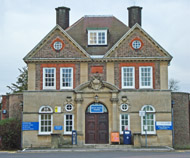
The main entrance to the Hospital. This building contains the new chapel.
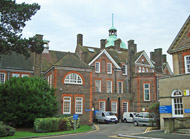
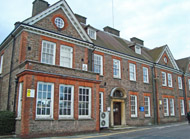
The original main building of the Hospital with a clock tower is to the south of the main entrance (left). The administration building (right) is to the north of the main entrance.
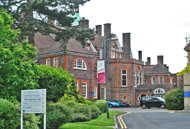
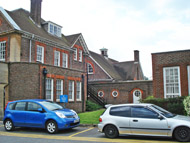
Various of the original buildings are still in use.
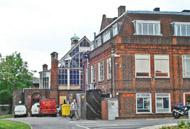
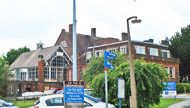
The east end of the original main building with a Solarium now contains the Histology Department.
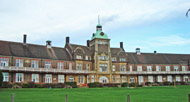
The back of the main building and its clock tower.


The southern elevation of the old main building.
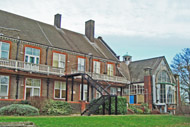

The East Solarium, a sunroom at the eastern end of the main building, now houses the Histology Department (left). The back of the eastern end of the main building, as seen from the east (right).

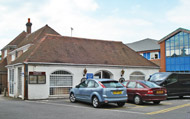
The commercial sector - a shopping precinct in the centre of the site - just south of the Princess Christian Unit (left). The Voluntary Services Office (right).
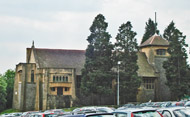
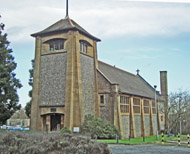
The former Hospital chapel, dedicated but never consecrated, is surrounded by a sea of cars. Built of York stone and flint, it is now Grade II listed and has been converted into a Library and Conference Centre.
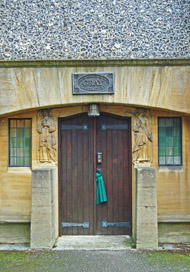
The entrance to the former chapel with Art Nouveau carvings on either side of the door.


The Medical Block containing the Daniel Ward Day Hospital. The front of the building is shown on the left and the back on the right.

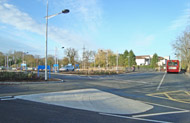
The Rainsford Mowlem Regional Burns Unit in 2008. The entire Plastic Surgery sector has been demolished and is now a car park.

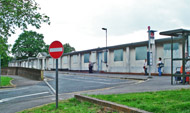
By the bus stands at the northeast of the site, these one-storey buildings were boarded up in May 2008. Presumably they were some of the hutted wards built during WW2. They have also been demolished and are part of the new car park.
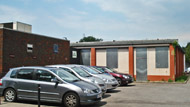
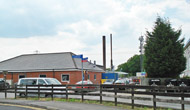
Another boarded up building awaiting development or demolition in 2008 (left). The boilerhouse chimneys and a radio mast can be seen in the distance (right).
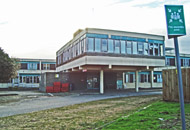
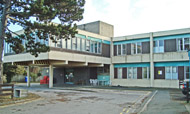
The former Out-Patients Department built in 1968 (above) and the Trinity Theatres (below).
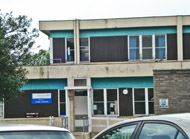
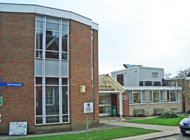
The Postgraduate Centre and Library, which also opened in 1968, was refurbished and extended in 1992.
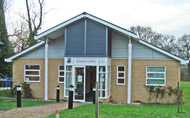
The Paul Strickland Scanner Centre was officially opened in 1986 by the Duchess of Kent. The Centre is entirely funded by voluntary contributions.
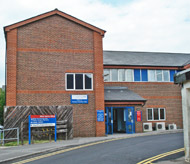
Once the Princess Christian Unit, this building has been absorbed into the new Mount Vernon Treatment Centre. This part is now the Minor Injuries Unit.
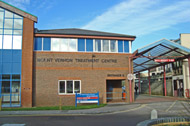
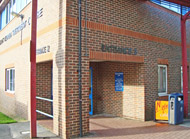
The former Princess Christian Unit, now part of the new Treatment Centre.

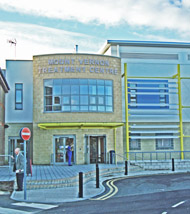
The new Mount Vernon Treatment Centre (left) and its main entrance (right).
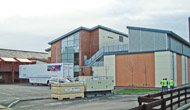
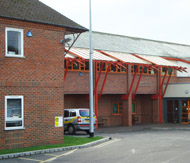
The Cancer Centre (left) at the southwest of the site and its entrance (right).
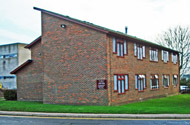

Chart Lodge, a residence for cancer patients attending for treatment.
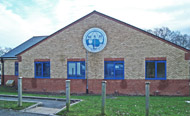
 Michael Sobell House (above and below), a hospice which opened in 1977.
Michael Sobell House (above and below), a hospice which opened in 1977.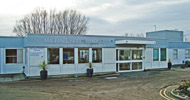
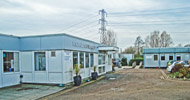
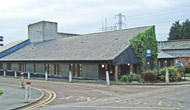
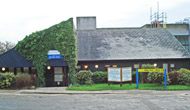
The Lynda Jackson Macmillan Centre.
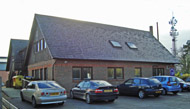
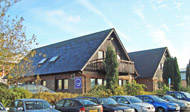
The Swiss chalet-style buildings of the RAFT Institute of Plastic Surgery to the west of the Day Hospital even have little balconies.
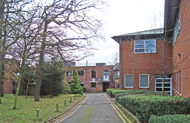
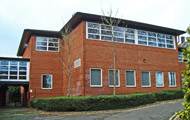
The Gray Cancer Institute (above and below) has relocated to the University of Oxford.
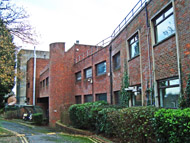
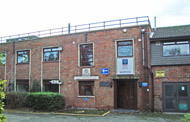
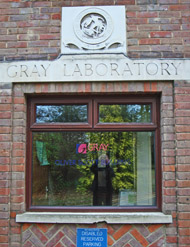

The Gray Laboratory signage remains.

The BMI Bishops Wood Hospital belongs to the private sector.
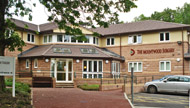
The Mountwood Surgery on Rickmansworth Road, just inside the southern entrance to Mount Vernon Hospital.
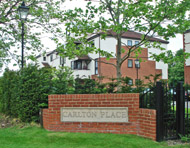
Carlton Place - luxury housing - has been built to the north of the campus on the site of the former staff accommodation.
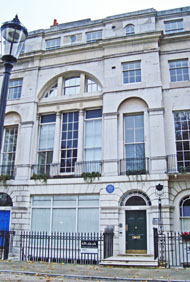
The third Out-Patients Department in central London from 1902 until 1932 at 7 Fitzroy Square, once the home of the painter Sir Charles Eastlake.
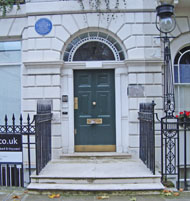
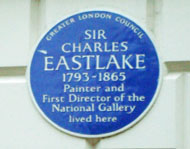
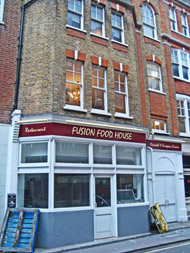
The fourth Out-Patients Department in central London (the Diagnostic Centre) from 1932 unrtil 1946 at 14 Riding House Street, now a defunct restaurant.
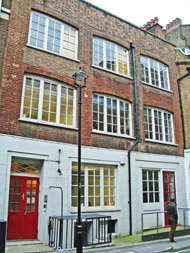
The Radium Institute was next door at 16 Riding House Street.
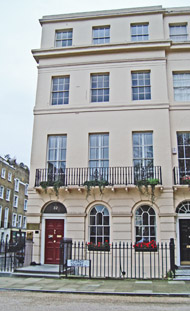
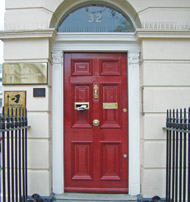
No. 32 Fitzroy Square, the fourth site of the Hospital offices in central London, from 1932 until 1947.
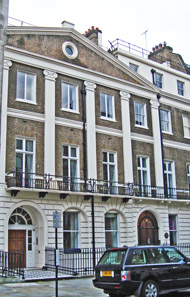
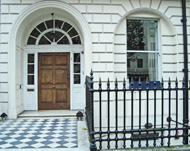
The fifth and final Out-Patients Department in central London at 59 Portland Place.
Bowlt E 2001 Healthy site to build a hospital. Ruislip & Northwood Gazette, p. 8 (July 18).
Dawson RLG 1988 The history, antecedents and progress of the Mount Vernon Centre for Plastic Surgery and Jaw Injuries, Northwood, Middlesex 1939-1983. British Journal of Plastic Surgery 41, 83-91.
Harris RI 1922 Heliotherapy in surgical tuberculosis. Canadian Medical Association Journal 12, 799-805.
Tremlett R (undated - ? 1999) A Palace of Hope. The Story of Mount Vernon Hospital Hampstead and Northwood. Publisher unstated.
www.british-history.ac.uk
www.enherts-tr.nhs.uk
www.francisfrith.com
www.geograph.org.uk
www.graylab.ac.uk
www.harrowpct.nhs.uk
www.harrowtimes.co.uk
www.hillingdon.nhs.uk
www.hillingdontimes.co.uk
www.mtvernon-cosmeticsurgeons.co.uk
www.nhs.uk
www.publications.parliament.uk
www.thh.nhs.uk
Return to home page